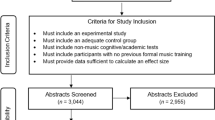Abstract
The purpose of this investigation was to compare fine motor task completion when using video models presented on a smaller screen size (Personal Digital Assistant) compared to a larger laptop screen size. The investigation included four high school students with autism spectrum disorders and mild to moderate intellectual disabilities and used an adapted alternating treatments design with baseline, extended baseline, comparison, and final treatment conditions. Results showed that although independent completion of fine motor office related tasks increased under both procedures, use of video models on the larger screen resulted in a higher percentage of correct responses across all four students.


Similar content being viewed by others
References
Billingsley, F. F., White, O. R., & Munson, R. (1980). Procedural reliability: A rational and an example. Behavioral Assessment, 2, 229–241.
Carey, A. C., Friedman, M. G., & Bryen, D. N. (2005). Use of electronic technologies by people with intellectual disabilities. Mental Retardation, 43, 322–333.
Cihak, D., Fahrenkrog, C., Ayres, K. M., & Smith, C. (2010a). The use of video modeling via a video iPod and a system of least prompts to improve transitional behaviors for students with autism spectrum disorders in the general education classroom. Journal of Postive Behavior Intervention, 12, 103–115.
Cihak, D. F., Kessler, K. B., & Alberto, P. A. (2008). Use of a handheld prompting system to transition independently through vocational tasks for students with moderate and severe intellectual disabilities. Education and Training in Developmental Disabilities, 43, 102–110.
Cihak, D. F., Wright, R., & Ayres, K. M. (2010b). Use of self-modeling static-picture prompts via a handheld computer to facilitate self-monitoring in the general education classroom. Education and Training in Autism and Developmental Disabilities, 45, 136–149.
Davies, D. K., Stock, S. E., & Wehmeyer, M. L. (2002). Enhancing independent time-management skills to individuals with mental retardation using a palmtop personal computer. Mental Retardation, 5, 358–365.
Gentry, T., Wallace, C., Kvarfordt, C., & Lynch, K. B. (2010). Personal digital assistants as cognitive aids for individuals with autism: Results of a community-based trial. Journal of Vocational Rehabilitation, 32, 101–107.
Gillette, Y., & DePompei, R. (2008). The potential of electronic organizers as a tool in the cognitive rehabilitation of young people. Neurorehabilitation, 19, 233–243.
Hammond, D., Whatley, A., Ayres, K. M., & Gast, D. L. (2010). Effects of video modeling to teach iPod use to students with moderate intellectual disabilities. Education and Training in Autism and Developmental Disabilities, 45, 525–538.
Kennedy, C. (2005). Single-case designs for educational research. Boston, MA: Pearson.
Mechling, L. C., Gast, D. L., & Seid, N. H. (2009). Using a personal digital assistant to increase independent task completion by students with autism spectrum disorder. Journal of Autism and Developmental Disorders, 39, 1420–1434.
Mechling, L. C., Gast, D. L., & Seid, N. H. (2010). Evaluation of a personal digital assistant as a self-prompting device for increasing multi-step task completion by students with moderate intellectual disabilities. Education and Training in Autism and Developmental Disabilities, 45, 422–439.
Mechling, L. C., & Gustafson, M. (2008). Comparison of the effects of static picture and video prompting on completion of cooking related tasks by students with autism spectrum disorder. Journal of Special Education Technology, 23(3), 31-45.
Mechling, L. C., & Savidge, E. J. (2011). Personal digital assistant using a personal digital assistant to increase completion of novel tasks and independent transitioning by students with autism spectrum disorder. Journal of Autism and Developmental Disorders, 41, 687–704.
Mechling, L. C., & Youhouse, I. R. (2012). Comparison of task performance by students with autism and moderate intellectual disabilities when presenting video models on large and small screen sizes. Journal of Special Education Technology, 27, 1–14.
Schopler, E., Reichler, R., DeVillis, R. F., & Daly, K. (1988). The childhood autism rating scale. Los Angeles, CA: Western Psychological Services.
Sparrow, S. S., Balla, D. A., & Cicchetti, D. V. (1984). Vineland adaptive behavior scales. Circle Pines, MN: American Guidance Services.
Taber-Doughty, T., Patton, S. E., & Brennan, S. (2008). Simultaneous and delayed video modeling: An examination of system effectiveness and student preferences. Journal of Special Education Technology, 23(1), 1–18.
Van Laarhoven, T., Johnson, J. W., Van Laarhoven-Myers, T., Grider, K. L., & Grider, K. M. (2009). The effectiveness of using a video iPod as a prompting device in employment settings. Journal of Behavioral Education, 18, 119–141.
Van Laarhoven, T., Van Laarhoven-Myers, T., & Zurita, L. M. (2007). The effectiveness of using a Pocket PC as a video modeling and feedback device for individuals with developmental disabilities in vocational settings. Assistive Technology Outcomes and Benefits, 14(1), 28–45.
Wechsler, D. (1997). Wechsler adult intelligence scale-III. Dan Antonio, TX: Psychological Corporation.
Wolery, M., Gast, D. L., & Hammond, D. (2010). Comparative intervention design. In D. L. Gast (Ed.), Single subject research methodology in behavioral sciences. New York, NY: Routledge.
Acknowledgments
The research reported here was supported by the Institute of Education Sciences, U.S. Department of Education, through Grant R324A100094 to the University of Georgia. The opinions expressed are those of the authors and do not represent views of the Institute or the U.S. Department of Education.
Author information
Authors and Affiliations
Corresponding author
Rights and permissions
About this article
Cite this article
Mechling, L.C., Ayres, K.M. A Comparative Study: Completion of Fine Motor Office Related Tasks by High School Students with Autism Using Video Models on Large and Small Screen Sizes. J Autism Dev Disord 42, 2364–2373 (2012). https://doi.org/10.1007/s10803-012-1484-1
Published:
Issue Date:
DOI: https://doi.org/10.1007/s10803-012-1484-1




